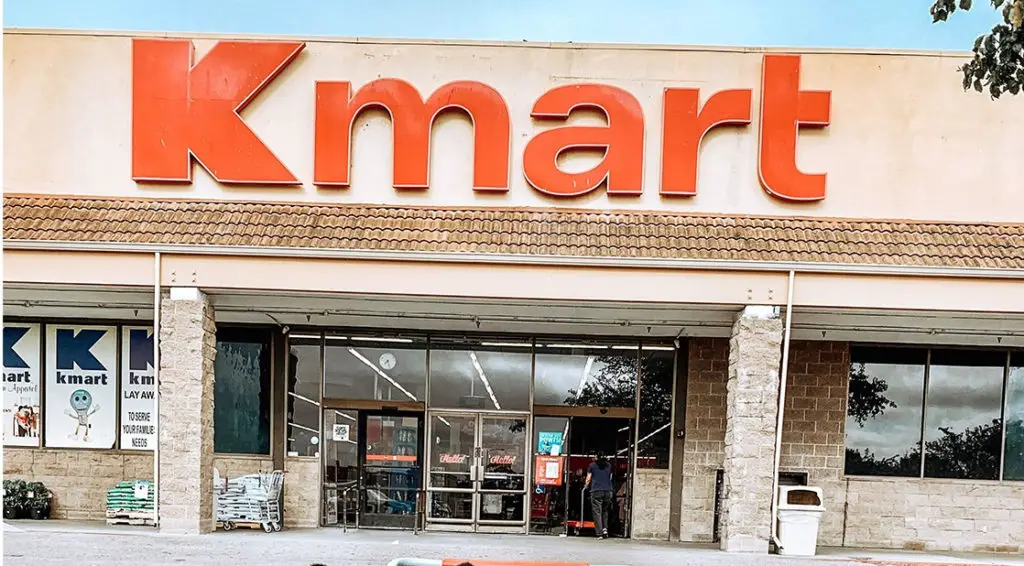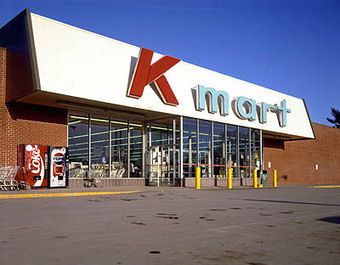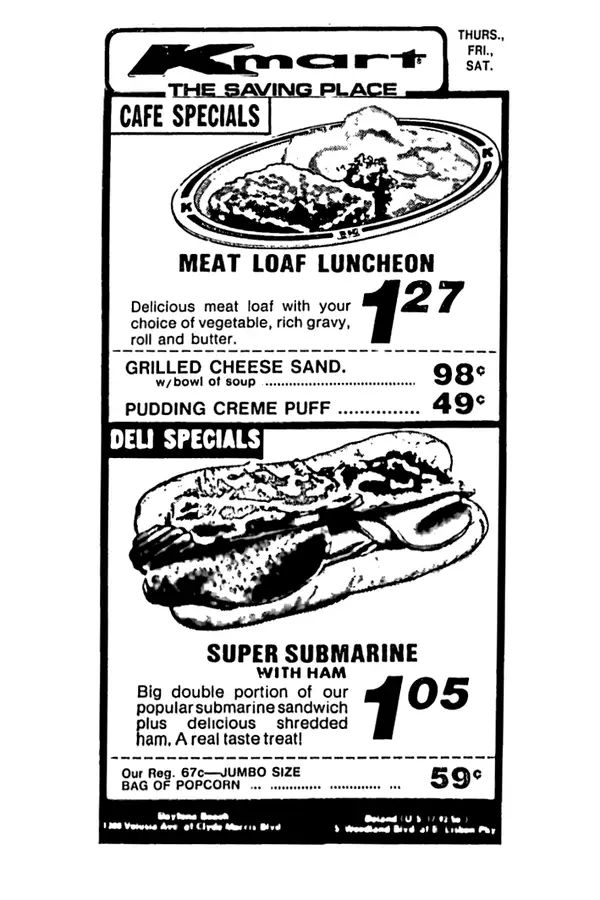
I don’t care where you lived, or what age you are, Kmart was part of all our lives in the 80s. Here in Canada, in the 1980s, we didn’t yet have Walmart. But we had Zellers, which was like our equivalent to K-Mart. But Kmart still existed. And both were part of our retail existence.
But Kmart had a bigger North American presence. They were everywhere, and you could get everything. For a kid, it was kind of a thrill to go to Kmart. Most kids hate shopping, but there was something about Kmart. Whether it was the restaurants, the huge toy sections, or just hiding in the racks of clothes, it felt like a mini-adventure.
It was the place to find low prices, and who could forget the blue light specials where a flashing blue light would alert you to the sales going on in the store?
The company has been around for quite a while and is now slowly fading away. A few stores still remain, but it is far removed from its glory days. Even though it started before the 1980s, this is a look back on the retail giant that was a part of life for all of us kids in the 80s.
Attention Kmart shoppers: This is the rise and fall of Kmart.
The Origins of Kmart
As of the time of writing this, there are just three Kmarts left. But during its heyday, there were well over 2,000 of them. But where did this store with the giant K come from?
One of the most interesting things is that back in 1962, both Kmart and Walmart started within a few months of each other. Kmart seemed to have a bigger rise to prominence and felt like more a part of America at first. Eventually, Walmart would catch up, and surpass them.
But Kmart was the original King of the ‘marts. How did this happen? Let’s go back to the start.
Sebastian S. Kresge was the man behind Kmart. If you’re wondering where the ‘K’ in Kmart comes from, it’s from Kresge. He didn’t start out right away with Kmart, but had some other retail stores. This was in 1899 and the stores were simply called S.S. Kresge Co.–which sounds like an aircraft carrier.
They were simple 5 and 10 cent stores that sold a variety of goods. These stores ran for a while and he incorporated in 1912. By 1918, he had 85 stores and the company was being traded on the New York Stock Exchange.
Not too many people know about the man behind Kmart, but this guy was an absolute heavyweight. By 1924 he was worth $375 million, which converted for today is nearly $4 billion. There’s a pretty big gap between this time period and the very first K-Mart, but it was the same story with the S. S. Kresge Co, stores: people just wanted to buy decent quality items for cheap. So the first Kmart would open in 1962 in Garden City, Michigan.
Fun Fact: This location lasted all the way till 2017.
The Growth of Kmart

Kresge obviously had a good handle on how retail stores operated. He also knew how to grow and expand them. Kmart was no different. The store rapidly expanded, and by 1977, Kmart was making a majority of the money for the Kresge Company.
This is when they would change the name of the company to the Kmart Corporation.
Kmarts were now everywhere, and they offered low-cost items and a very wide range of them. The stores were pretty simple with their red and white color scheme, but they didn’t need to be anything more than what they were: this wasn’t Bloomingdales, after all.
The rapid growth would lead to spin-off Kmart stores such as Super Kmart Centers and Big Kmart.
By 1981, the 2000th Kmart store was opened. They had expanded here into Canada, and by the end of the year were up to 2,055 stores. But even in the 1980s, those old Kresge stores were still holding on. In the 80s, there were still 76 of them, but the company would sell them off and go all-in on Kmart.
One thing Kmart did–which we also had in Zellers here in Canada–was to include dining options in their stores. This was another perfect idea. Since most families were shopping with kids, what better way to keep them in the store, make more money, and deal with hungry, screaming kids, than by having a restaurant available?
This was great for parents as they didn’t have to leave for a nearby McDonald’s to shove a Happy Meal in their screaming kid’s face. They could stay in the store and kill two birds with one stone.
Kmart even looked to take this to the next level in the 1980s. They started experimenting with co-branding by bringing in Wendy’s restaurants in some of their locations. This never took off, but it’s surprising that it never caught on the way McDonald’s in a Walmart would.
But Kmart was the perfect place to shop; you could run in for just one thing, or load up an entire shopping cart. Anytime I went to a friend’s birthday party, we would buy them a toy at Kmart. Most of the G.I. Joe toys I had were from Kmart, as they were even cheaper than Zellers. When I think of Kmart, I also always think of back-to-school shopping.
Many also have great memories of Kmart at Christmas, and you can still listen to their original in-store Christmas music playlists here on YouTube.
And if you want another shot in the nostalgia gland, here’s a classic old Kmart Christmas commercial from the 80s.
The Blue Light Specials
Not to be confused with a red light special… This was actually a pretty ingenious piece of marketing. And it also may have been a bit ahead of its time. The blue light special started all the way back in the late 60s and ran until 1991. The concept seems pretty simple, but that’s what made it so effective.
In case you don’t remember this, Kmart would have flashing blue light sirens on top of polls that would light up when a specific item would go on sale. You didn’t exactly know when this was going to happen, and people would hang out for ages, hoping to catch one.
This was great for a few reasons. First, it gave Kmart a specific brand identity. No one else was doing the blue light specials. The next big thing is that it kept people in the stores longer. If you knew that a sale might come up, you would just have to hang out and browse until that blue light went off.
In the world of retail, the longer that you can keep someone in a store, the more money they spend. It’s the reason they design grocery stores the way they are. Have you noticed every grocery store you’ve ever been to has the same layout? The outer perimeter brings you around to the aisles. At the end of the aisles, you see the “end caps.” These are where they display sale items that entice you down the aisle.
At the end of all the aisles are the cash registers, and if you’re not ready to pay, you head up the next aisle. This weaving up and down the aisles keeps us in longer, exposes us to thousands of products, and makes it more likely for us to spend more.
This is also why grocery stores put their most bought items: milk, bread, and eggs, in the very back of the store. This forces you to walk through the entire store–and again, get exposed to thousands of products–just to get the few items you need.
This was part of the genius with the blue light special. And, just as importantly, the blue light special was a great way to clear out inventory.
Early Signs of Decay & the First Bankruptcy
We often think of the downfall of Kmart happening in the last decade or so, but this was already the case in the 1980s and going into the 90s. Remember, by the end of the 80s, these stores had already been around for nearly 30 years. Many of them were getting rundown and looked outdated. And by the end of the 80s, the company had expanded to much more than just the Kmart stores.
In 1990, they bought the Sports Authority. They then bought a large percentage of Office Max. In 1992, they bought Borders Book Stores. The company was expanding quickly, and suddenly, the Kmart stores weren’t a big priority.
But maybe they took on too much at once? They invested so quickly, and so widely, that it didn’t exactly pay off. In 2002, they had already filed for bankruptcy. But this wasn’t the Michael Scott, trying to erase everything bankruptcy–they filed for the reorganization kind.
In 2004, we got a form of retail worlds colliding. Kmart Holdings Corporation became the Sears Holdings Corporation. But Sears hadn’t purchased Kmart, Kmart had acquired Sears and just kept the name.
I don’t think many people realized that by the mid-2000s, these two giant companies were combined. They were the top two retail stores in the 80s and 90s, and it’s surprising that there was never any government intervention to try and stop it. But in reality, this shows how far the two retail giants had fallen.
It was around this time that Kmart went for a rebrand with its logo. They started with the famous one we know: the red K followed by the blue ‘mart,” went to the giant red K with the diagonal white “mart” in the 90s, and that was replaced with a red K with the word “kmart” underneath.

Hanging by a Thread?
This story starts in the early 60s, picks up huge traction in the 1980s, peaks in 1994, then slowly begins a descent. We pick things up in 2006. Unbeknownst to us, Sears and Kmart are now essentially the same company.
At their peak in 1994, there were 2,486 Kmart stores. In 2006, there were only 1388. This was a massive drop over that twelve-year period. It would get worse. In the next ten years, from 2006 to 2016, the company would only end up with 735 stores. Revenue would also be cut in half during this time period.
But it was technically worse than this sounds. Not only are the stores not making much money, but the company also has a ton of debt. This means you have to look at how much money is left over after all debts are paid–and this is one of the true signs of a company’s value.
Ideally, you want your company to have low debt and high equity.
There are some calculations that I don’t understand that reflect this debt-to-equity value, but these calculations give you a number. A high number means a lot of debt and not much income. A lower number means low debt and high income. In retail, anything around a 2 is supposed to be good and you don’t want to be too much higher. Kmart was a 14.
This was in 2014. Things actually weren’t too bad all the way up to 2011 as that magic debt number was always below 2. In 2011 it went up 4, then 5, then 7, then to that eye-watering 14.
The company now had negative equity and basically couldn’t pay off its debts. All those blue light specials and Kathy Ireland clothing weren’t exactly filling the company’s pockets. Kmart was in a tough situation. Even if they sold off everything, they still wouldn’t have enough to pay all their debts.
Keep in mind: Kmart hasn’t disappeared. They’ve dwindled down to nearly nothing, but as of the time of writing this; still exist. This is kind of astonishing. The company has been operating at a loss since 2011.
Kmart has now filed for bankruptcy twice. Even though it wasn’t what it was in its heyday, the company still made $49 billion in 2005. By 2020, it was down to just $3.2 billion.
Where Did it all Go Wrong For Kmart?
After looking back at all this, Kmart reminds me of the Black Knight from Monty Python. Despite being chopped down to size, he somehow remains and refuses to recognize his defeat (‘tis but a scratch).
As usual, you can’t pinpoint the downfall of a company to one thing. There are obviously several that caused the decline of Kmart. I think the first thing is obviously the competition. As Walmart and Target came into prominence, it let us see how lackluster Kmart really was. The last remaining Kmarts were kind of junky. Brand new Targets and Walmarts were big, bright, and shiny. The shelves were always full and their stores were way cleaner.
Many Walmarts also had full grocery stores so you could get everything in one trip. Another issue is that many of the Kmarts tended to be in less desirable areas. They would be part of run-down strip malls and were often in inconvenient locations. With Walmarts and Targets, not only were they easier to get to, but they are often right next to each other. Combine this with an Old Navy, Home Depot, and Best Buy, and you’ve got the ultimate one-stop shopping.
And of course, online shopping plays a huge part, too. I get a lot of stuff off Amazon, and if I need to physically go out, I head to the Walmart that’s only five minutes away. With all of these changes, a Kmart didn’t make that much sense anymore.
In the 1960s, 70s, and 80s, Kmart was our Walmart. We would head there even if it was to just pick up one thing. For most of these decades, they really were the only game in town.
Would Kmart have benefited from an entire rebrand? It’s hard to tell. And it’s hard to tell when the right time for that would have been. The decline was slowly starting to happen in the early 90s, but they were also at their peak. So that wouldn’t have made any sense. Maybe by the early 2000s? I wonder if they thought they would just be able to push through. Also, I’m not totally sure how you would rebrand a Kmart.
The stores drastically needed updating, but never got that. They were already outdated in the 1990s let alone up to a few years ago. They were even still using the same outdated computer monitor registers. There were no touch screens, self-checkout, or modern inventory systems.
Apparently, Kmart customers waited in line twice as long as in any other store. That didn’t help.
The other big problem is even if they wanted to do a full overhaul, they just didn’t have the money for it. We all know hindsight is 20/20, but we can see now that instead of purchasing those other companies–including another dying brand, Sears–that money may have been better used if it was invested back into Kmart.
Although Kmart has hung on this long, I imagine it’s been impossible to recruit people to work for them. I can’t see any high-level executive leaving their position to try to save a company that was facing a rapid decline. So, as mentioned, there isn’t one reason for the decline of Kmart, but a combination of many factors.
But credit to a company for actually hanging on to the bitter end. As of today, the last three Kmarts are in Westwood, New Jersey, Bridgehampton in (sorry, on) Long Island in New York, and the last one in Miami.
Final Thoughts

The last time I was in a Kmart was about 6 years ago. And it felt like I was walking back into the past. Yes, products and prices change, but the store didn’t seem to. Every time I walked into a Kmart, it felt like going into a time machine as everything seemed the same as when I was a kid.
I’ll be honest, the Kmarts I had been to weren’t exactly the most aesthetically pleasing places. Many of them that were still in operation were pretty run down and not well maintained. But the company isn’t going down without a fight.
You could say the heyday of the department store is long gone. Kmart, Sears, Zellers, and many similar stores are on their way out– if not already gone. Those department stores of our past just couldn’t keep up with the big box stores and their cheaper prices. And as we moved our shopping online, there was no way to keep up with giants like Amazon.
It’s actually pretty impressive that Walmart remains such a juggernaut considering we all shop online. Will people in the future make trips to visit one of the last remaining Walmart stores? Will it go the way of Kmart? There’s no way to tell, but In either case, Kmart remains a pretty beloved part of our childhood in the 1980s.




Comments
Comments are closed.